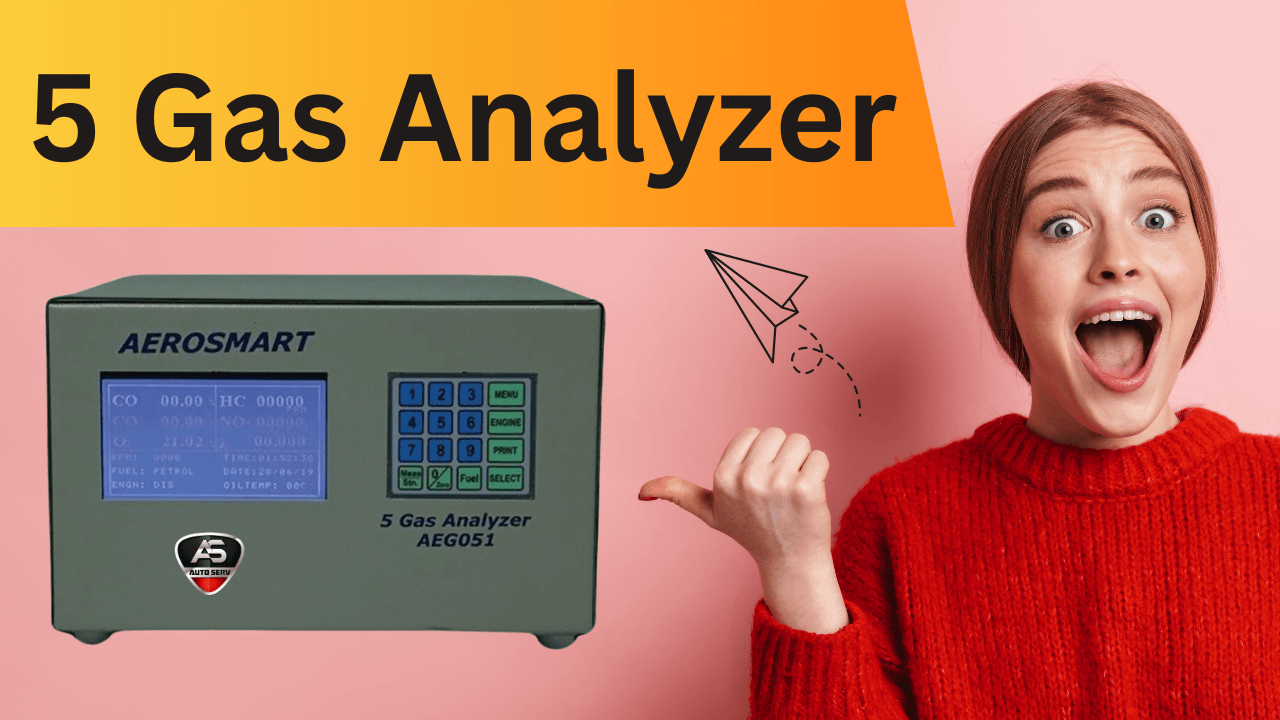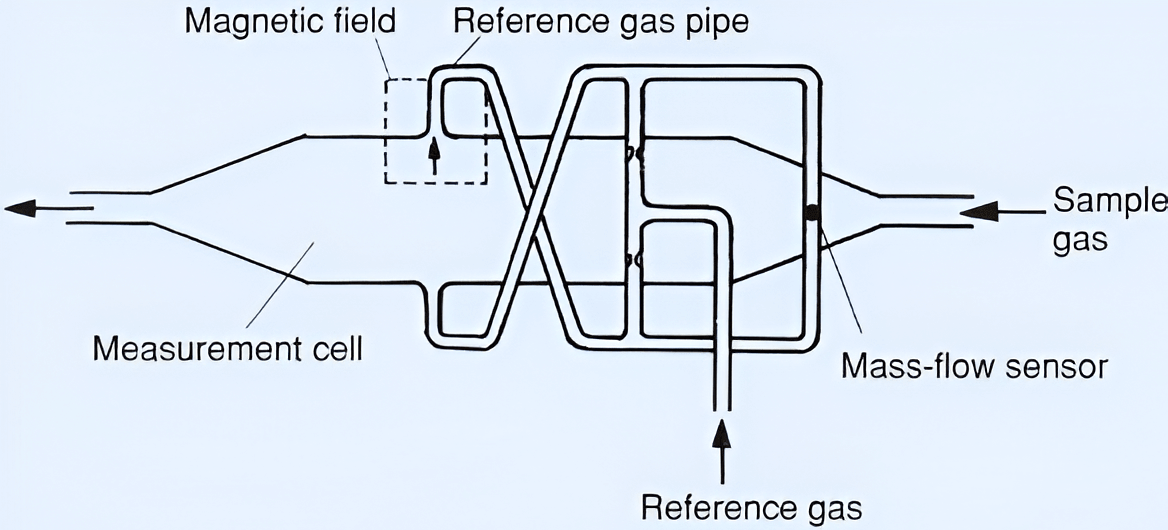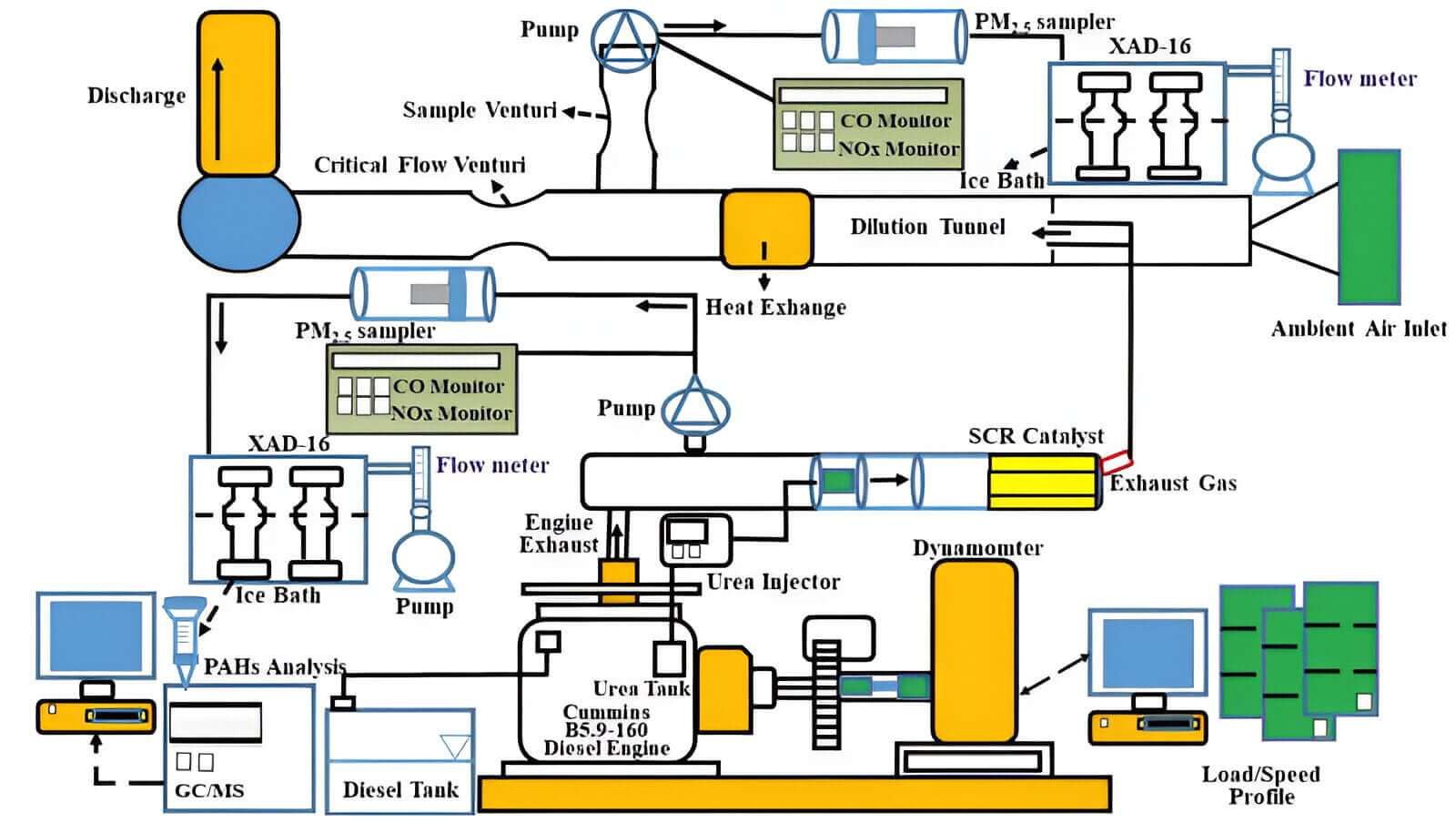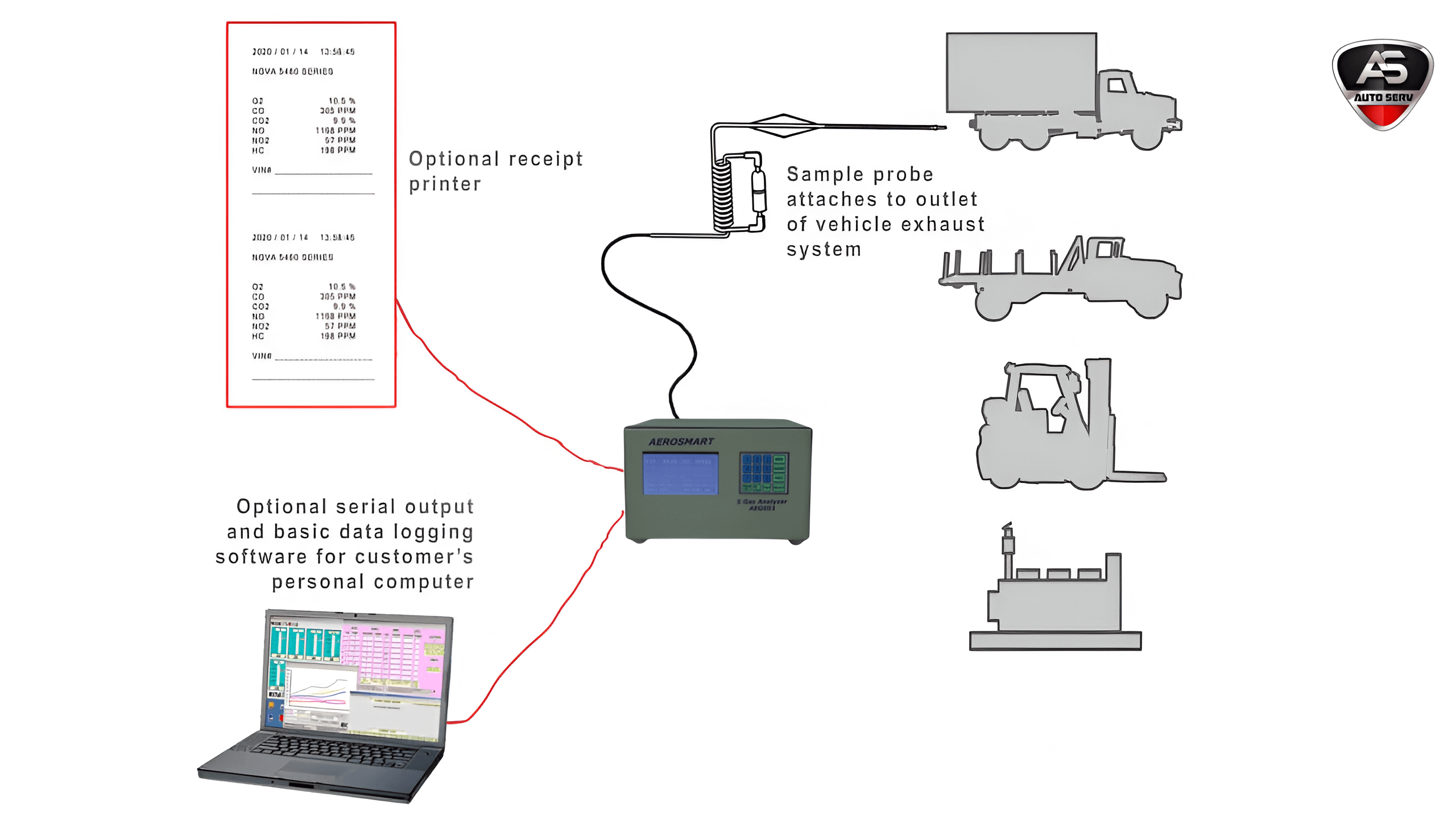Five Gas Analyzer Detailed Guide – Understanding the 5 Gas Analyzer
In today’s automotive world diagnostics vehicles and having perfect accuracy are important. A five-gas analyzer is an important tool for diagnosing vehicle pollution. It ensures that our vehicle’s engine working well.

This powerful device tests five harmful gas levels from a vehicle exhaust. It helps mechanics and vehicle owners to understand and improve engine performance and emissions. This is a complete guide.
We’ll share a knowledgeable article to understand it. What is a five-gas analyzer, and how it works? We’ll also cover why it’s important and how to use it well.
What is a Five Gas Analyzer? Let’s cover Five Gas Analyzer Detailed Guide
A five-gas analyzer is a pollution diagnostic machine. It checks the below given five gases from the vehicle’s exhaust. These gases include:
- Carbon Monoxide (CO)
- Carbon Dioxide (CO2)
- Hydrocarbons (HC)
- Oxygen (O2)
- Nitric Oxide (NOx)
Each gas provides critical data about the engine’s combustion. It helps to find potential issues. This device is too important for vehicle technicians. They use it to check vehicle pollution levels and meet emission rules.
How Does a Five Gas Analyzer Work?
The five-gas analyzer works by taking an exhaust gas sample. Inside, it uses sensors. They use infrared tech to measure each gas level. Let’s check the steps involved:

1. Sampling
The analyzer uses a pipe inserted into the vehicle’s exhaust pipe to collect a gas sample.
After that, the sample is drawn into the device for analysis.
2. Measurement
Inside the analyzer, various sensors and detectors check each gas level. These sensors use principles like infrared absorption for CO and CO2. It uses flame ionization for HC and electrochemical cells for O2 and NOx.
3. Data Display
The analyzer then processes the data. It shows the levels of the gases. This information is important for vehicle performance and emissions issues.
The Importance of Measuring These Gases
The analyzer measures many gases. Understanding their importance is essential. It helps in explaining the results and making informed changes.

1. Carbon Monoxide (CO)
CO is a toxic gas generated by incomplete burning. Its high levels show that the engine is not burning fuel well. This can be done by mixed fuel, poor ignition, or other issues. Reducing CO levels is important for both engine performance and environmental safety.
2. Carbon Dioxide (CO2)
CO2 complete burning is a natural by-product. Checking CO2 levels helps to ensure the burning process is working well. Higher CO2 levels generally indicate better burning capacity.
3. Hydrocarbons (HC)
HC represents unburned fuel in the exhaust. High HC levels mean the burning process is incomplete. This can be done by spark plug damage or poor fuel. Reducing HC levels is good for decreasing pollution and improving engine health.
4. Oxygen (O2)
O2 levels in the exhaust, help estimate the air-fuel ratio. Too much oxygen indicates a lean mixture, while too little oxygen suggests a rich mixture. Proper O2 levels are important for the best engine performance and fuel power. Balancing the air-fuel mixture can enhance engine power and reduce emissions.
5. Nitric Oxide (NOx)
NOx gases are developed at high burning temperatures. High NOx levels mean the engine is hot. This can harm the engine and raise pollution. Reducing NOx levels can prevent engine damage.
Benefits of Using a Five Gas Analyzer

1. Improved Engine Performance
A five-gas analyzer provides an exact pollution result test. It helps find engine problems to improve engine performance and power. This machine shows the vehicle pollution levels. These changes enhance fuel burning and make a perfect engine.
2. Reduced Emissions
Engine repair based on gas analyzer test readings. This process saves from harmful emissions and helps the environment. Reducing HC and NOx levels helps maintain environment friendly. It also reduces the vehicle’s pollution level.
3. Cost Savings
Finding and adjusting engine issues early can prevent bigger, costlier problems later. It saves money on repairs and fuel by warning through pollution results. This stops heavy damage and avoids costly repairs.
4. Compliance with Regulations
Use a five-gas analyzer. It makes sure our vehicle is under emissions standards. It helps you avoid fines and legal issues. This is important for car workshops and service centers.
How to Use a Five-Gas Analyzer
Using a five-gas analyzer involves several steps. It has done accurate readings and proper diagnosis.

1. Warm Up the Engine
Check the engine is at a hot temperature for accurate readings. A cold engine may produce different test results. This is compared to an engine at normal operating temperatures.
2. Connect the Analyzer
Attach the analyzer’s pipe to the vehicle’s exhaust pipe. Check the connection is secure and leak-free to avoid the wrong sample.
3. Take Readings
Start the analyzer to check the exhaust gas and display the readings. Make sure the vehicle is in good and stable condition. Do this process to get accurate data.
4. Checking the Result Data
Use the readings to diagnose any issues and make necessary adjustments to the engine. For instance, high HC levels may mean you need to replace spark plugs or adjust the fuel injectors.
Practical Applications and Case Studies
To explain the practical applications of a five-gas analyzer, here are the following scenarios:
Case Study 1: Diagnosing High CO Levels
A vehicle comes into the shop with complaints of poor fuel economy and a strong exhaust smell. The technician uses a five-gas analyzer and finds high CO levels. This indicates incomplete burning.
This is likely due to a rich air-fuel mixture. Further inspection reveals an incorrect oxygen sensor. After replacing the sensor it restores the right air-fuel mixture. This improves fuel efficiency and reduces CO emissions.
Case Study 2: Reducing NOx Emissions
Truck drivers need to obey all Nox emission rules. For knowing the Nox levels the technician uses a five-gas analyzer. They find that the truck has high NOx levels. The analysis shows that the engines are too hot.
This can be done by wrong timing settings. By adjust the engine timing and add EGR (Exhaust Gas Recirculation) systems. can reduce the temperature. This reduces the NOx levels.
Case Study 3: Balancing Air-Fuel Ratio
A car enthusiast wants to tune (best performance) their vehicle for the best performance. The tuner uses a five-gas analyzer. The technician checks the exhaust gases. It finds that the car is running slightly slow.
It has high O2 levels and lower CO2 levels. The technician adjusts the fuel injectors to provide a richer mixture. This achieves a better balance, resulting in more power and smoother acceleration.
Maintenance and Calibration of the Five Gas Analyzer
To keep a five-gas analyzer accurate and long-lasting, you need to do regular maintenance. You also need to do the calibration.

Regular Maintenance
- Clean the machine pipe often. This removes any dirt or debris. They could affect gas sampling.
- Check the sensors. Make sure they work well. Replace ones that are worn or wrong.
- Inspect Hoses and Connections. Check for leaks or cracks. This prevents contamination of the gas sample.
Calibration
- Follow Manufacturer Guidelines: Follow the manufacturer’s instructions for calibrating the analyzer. Calibration certifies that the readings are accurate and reliable.
- Use Calibration Gases: Certified calibration gases are used to calibrate the analyzer. These gases have known concentrations of the measured gases. The calibration provides accurate calibration.
- Regular Calibration: Calibrate from time to time. The calibration gap is specified by the manufacturer. This process keeps the analyzer accurate.
Advanced Features in Modern Five Gas Analyzers
Modern five-gas analyzers have advanced features. These features make them easier to use and work well.
Digital Displays and User Interfaces
Modern analyzers have digital displays that show clear, real-time data readings. User-friendly interfaces make it easier to navigate and explain the data.
Data Logging and Connectivity
Some analyzers can log the data. This allows users to record and store readings for later analysis. You can use USB or Bluetooth to transfer data. You can send it to computers or other devices. Then, you can analyze and report on it.
Portable and Compact Designs
Advances in technology created portable, compact five-gas analyzers. These are perfect for field use, and make it easier for technicians.
Advanced Diagnostics Software
Integrated software can offer advanced diagnostics, providing insights beyond basic gas concentration readings. For example, some software can suggest why readings are abnormal. This aids in quicker and more accurate diagnostics.
Summary is here
A five-gas analyzer is a must for an automobile garage and a pollution test is also mandatory for vehicle owners. It’s for serious vehicle owners who keep their vehicle’s performance perfect. It is also the best solution for the environment.
By getting your vehicle test reading you can adjust your vehicle and take suitable action.

For high-quality five-gas analyzers and other automotive equipment, visit AutoServindia. We provide top-quality equipment for the garage and personal uses.
It doesn’t matter if you’re a pro mechanic or a car lover. Our products and advice will support all your car diagnostic requirements.
Using a five-gas analyzer properly ensures that you’re always a step ahead. It helps in diagnosing and fixing engine issues. This extends the vehicle’s life.
It also helps the environment by making it cleaner and safer. Invest in a five-gas analyzer today.
Explore our Products and Washing Accessories
FAQs
A 5 gas analyzer can test CO, CO2, HC, O2, and NOx.
It diagnoses engine issues by analyzing exhaust gases. This helps optimize fuel efficiency and performance.
It ensures that the vehicle is under emission standards. This improves air quality and follows environmental rules.
It can find emission issues only. But, it may not detect other problems.
You should calibrate it often, usually every 6 to 12 months. And according to the manufacturer’s guidelines. Calibration is good for accurate results.
Five Gas Analyzer Detailed Guide | Five Gas Analyzer | Blood Gas Analyser | Flue Gas Analyser | Multi Gas Analyser | 5 Gas Analyser | Portable Gas Analyser | Residual Gas Analyser | Five Gas Analyzer



